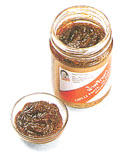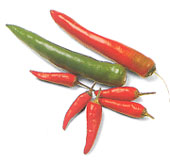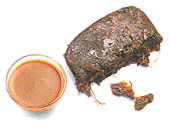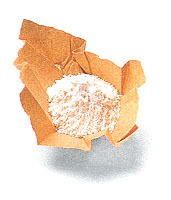( Home ) ( About Me) ( Thai Food Recipes ) ( Ingredients ) ( My Favorite links )
![]()
 |
BEAN SPROUTS Used mainly in salads and as a stir-fry vegetable, soya bean sprouts are crunchy,white,short sprouts. Discard any that are limp or brown,They are highly perishable so use within three days of purchase. Traditionally, the scraggy ends are removed. |
 |
CHILLI JAM OR PASTE Chilli jam is a sweet and sourish tangy jam that is sold in jars at Asian food stores. It is used in sauces, stir-fries and some soups. After opening, store it in the refrigerator. |
 |
BARBECUED PORK These are spit-roasted cuts of pork, available from speciality Chinese barbecue shops. Honey-smoked ham can be substituted if you wish. |
 |
BASIL There are three vaieties of basil that are used in Thai cuisine. Bai Horapha tastes rather like anise, looks like sweet basil, and is used in red and green curries. Bai Manglaek has a lemony flavour; tiny leaves and is usually sprinkled over salads or used in soups. Bai Grapao has a clove-like taste and purple reddish tinged leaves. It doesn't stor well, so buy just before you intend to use it. European basil can be used as a substitue for all varieties if you can't find the Thai varieties. Basil has a strong flavour, so don't use more than the recipe states. Some nurseries sell Thai basil, so try growing your own. |
 |
BLACK FUNGUS This is a Chinese ingredient used in some Thai dishes. It has no flavour but is used for its texture. It is a member of the mushroom family, available in dried form, and looks like dried, black, wrinkled paper. When soaked in water for about 10 minutes, it swells and resembles wavy seaweed or jelly. Stored in its dried form, it will keep indefinitely. |
 |
BEAN CURD Tofu is made from soya beans and is an excellent source of protein. A creamy-white, firm tofu is sold in blocks, wrapped in plastic, and is used in soups, stir-fries and salads. Fried tofu is golden brown on the outside, a little rubbery in texture and is added to salads and used as a garnish for soups, Fresh tofu doesn't have much taste when uncooked but absorbs other flavours. It should be refrigerated in water that is changed daily and used within a few days of purchase. |
 |
CHILLIES Chillies are a common ingredient in Thai cuisine, although not all dishes are hot. Chillies come in a great variety of sizes, shapes and colours, and are available fresh and dried, as flakes and powder. The most commonly used fresh chillies are bird's-eye chillies--small, thin,green or sometimes red, chillies. Generally, the larger the chilli the milder the flavour--the very tiny red chillies can be very hot. To avoid skin irritaion, take great care when seeding or chopping chillies--wear rubber gloves. After handling chillies don't touch your face, eyes or any tender part of the body and always wash your hands thoroughly. If you like a hot curry, leave the seeds in, but if you preder a milder flavour, the seeds can be removed to lessen the heat. Whole chillies freeze well in plastic bags and can be chopped frozen. Some chillies are available dried and are usually soaked in water, to soften, before use. |
 |
PALM SUGAR Obtained from either the palmyra palm or sugar palm,it is available in block form or in jars. The colour ranges from pale golden to very dark brown. Palm sugar is thick and crumbly and can be gently melted before adding to sauces or dressings. Soft brown sugar, demerara, or coconut sugar can be substituted, if necessary, Palm sugar is available from Asian food speciality stores. |
 |
DRIED SHRIMP Tiny salted shrimp that have been dried in the sun. They are used for flavour, especially in sauces. |
 |
CORIANDER Also known as cilantro, coriander is the most common herb used in Thai cooking. The whole plant is used--the root, stem and leaves. The seeds are roasted and then ground in a spice mill and used in curry pastes. Fresh coriander is available from Asian food stores, greengrocers, or in pots from plant nurseries. The leaves are used for their fresh, peppery flavour, and as a garnish. For storage, wash and dry the fresh herbs before placing them in plastic bags in the refrigerator--they will keep for 5-6 days. Dried coriander is not a suitable substitute. |
 |
EGGPLANTS Many different sizes, shapes and colours are used in Thai cooking. Tiny pea-sized eggplants that are now available in some Asian food stores are often used--they can be bitter in flavour. Samll, long lady-finger eggplants are also used. European eggplants may substituted if Thai eggplants are not available. |
 |
RICE STICK NOODLES Rice stick noodles are flat. They are sold in bundles and used in noodle stir-fries and soups. |
 |
TAMARIND A tart-flavoured pulp that comes from the tamarind tree. It is an important ingredient in Thai cooking, and is available as a bottled puree, crystals or a pulpy solid that has to be soaked, kneaded and seeded. |
 |
SESAME OIL A very aromatic oil, made from roasted sesame seeds, used in Thai recipes that have a Chinese influence. Use it sparingly as a little goes a long way and it has quite a strong, rich flavour. Don't with it or use it as the only oil in a salad dressing. |
 |
SPRING ROOL WRAPPERS These are paper-thin wrappers, available fresh or frozen, used to make many wrapped snacks as well as pring rolls. Defrost frozen wrappers before use and keep them covered with a damp tea towel to prevent drying out. |
 |
RICE VERMICELLI Rice vermicelli are white and folded into a block. Their thickness and widths vary. They are used in stir-fries and soups, and need to be soaked in hot water or boiled until soft and then drained well before use. If they are to be used as a garnish or for the noodle sih, Mee Grob, the dried vermicelli is deep-fried until it puffs up. Rice vermicelli separate and puff up when deep-fried and a little goes a long way so always deep-fry in small quantities. |
 |
SNAKE BEANS These are long, deep green ,stringless beans which grow up to 30 cm. Cut in short lenghts, they are used in stir-fries, curries and sometimes soups, They have less flavour than other types of green beans but are easier to prepare. |
 |
OYSTER SAUCE A Cantonese staple found only in Thai dishes that have a Chinese influence, it is made from dried oysters. This rich, salty sauce is used for both flavour and colour, mostly in omelettes, stir-fries, soups or noodle dishes. It is readily available and should be kept refrigerated, after opening, to prevent mould forming. |
 |
RICE FLOUR Rice flour is used to thicked sauces and curries or bind meat mixtures. It is also used in desserts. Cornflour can be substituted, but doesn't impart the same texture. |
 |
TURMERICE A bitter spice used for its intense, bright yellow-orange colour. If your use the fresh root, peel away the skin and finely grate the flesh. It is readily available in powdered form. |
 |
GINGER A delicious, aromatic ingredient, important in Thai cooking. Fresh ginger is readily available--buy firm, unwrinkled rhizomes and store them in a platic bag so they don't dry out. |
 |
GARLIC An indispensable ingredient in Thai cookery, it is available in different varieties, some with very white papery skin, some with pink, some with pink and white skin and some creamy in colour. Choose cloves that are about 1 cm wide, otherwise adjust the quantity as you will find that some cloves are up to 2.5 cm wide. |
 |
LEMON GRASS An aromatic herb that is used in curry pastes, stir-fries and soups. Trim the base, remove the tough, outer layers, and finely slice, chop or pound the white interior. For pastes and salads, use the tender, white portion just above the root. The whole stem, trimmed and washed thoroughly, can be added to simmering soups and curries and removed before serving. Dried lemon grass needs to soak in water for half an hour before use, but the flavour of fresh is superior. |
 |
KAFFIR LIMES AND LEAVES A knobbly, dark-skinned lime with a very strong lime fragrance and flavour. The leaves are finely shredded for use in curry pastes and salads, or added whole to curries. The rind is also very pungent and is grated over salads, soups and curries. Fresh leaves are available from speciality greengrocers and Asian food stores, and they freeze well in airtight bags. Dried leaves are available from Asian food stores, but can only be added to foods which are simmered to allow to flavour to be released. If kaffir limes are not available, standard limes may be used for rind and juice, bearing in mind that the flavour is not quite the same. The leaves are not suitable as a substitue for kaffir lime leaves. |
 |
CRISP FRIED ONION AND GARLIC These are finely sliced garlic cloves or onions that have been deep-fried until crisp. They are added to soups, noodle dishes or salads just before serving. They are available in jars from Asian food stores or you can prepare them by finely slicing peeled onion and garlic and cooking over low heat in oil, stirring regularly until crisp and golden-brown. Drain well and allow to cool before seasoning with salt. This should be done just before serving. |
 |
CHINESE DRIED MUSHROOMS These impart a very distinct flavour to the dish and are used in Thai dishes that have a Chinese influence. They need to be soaked before use and are available from Asian food stores. Store in a sealed container in a cool place. |
 |
CHINESE CABBAGE Flongated in shape, this has pale green leaves and a slight mustard flavour. If it is unavailable, use another curly-leaf cabbage. |
 |
COCONUT MILK AND CREAM Coconut milk is extracted from the flesh for fresh coconuts--it is not the clear, watery liquid found in the centre of fresh coconuts. Coconut cream is quite thick, almost of a spreadable consistency. It its the product of the first extraction from the flesh. It is very rich and is usually added at the end of cooking time to enrich the curry or sauce or dessert. Coconut milk is a thinner consistency than the cream as it is extracted from the flesh after the cream has already benn produced. It is used in Thai curries and desserts. Good quality, canned coconut milk and cream are available from Asian food stores and supermarkets. Some brands call the thinner consistency coconut cream, so try different ones until you find the right consistency. Some times coconut milk separates and the fat solidifies on the top--if this happens, just stir it well. Once the can is opened the milk or cream doesn't keep, so freeze any leftovers in small amounts for future use. |
http://www.thaimenu.net/ingredients/